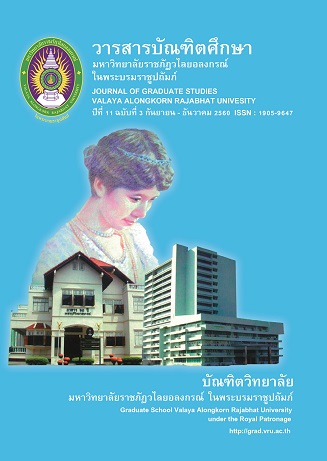การพัฒนาแบบวัดความสามารถพื้นฐานทางดนตรีไทย สำหรับนักเรียนระดับชั้นมัธยมศึกษาปีที่ 1: การประยุกต์ใช้ทฤษฎีการสรุปอ้างอิงความน่าเชื่อถือของผลการวัด (Generalizability Theory)
Main Article Content
Abstract
บทคัดย่อ
การศึกษาครั้งนี้มีจุดมุ่งหมาย 1) เพื่อสร้างแบบวัดความสามารถพื้นฐานทางดนตรี สำหรับนักเรียนระดับชั้นมัธยมศึกษาปีที่ 1 2) เพื่อตรวจสอบคุณภาพของแบบวัด โดยการประยุกต์ใช้ทฤษฎีการสรุปอ้างอิงความน่าเชื่อถือของผลการวัด และ 3) เพื่อเปรียบเทียบค่าสัมประสิทธิ์การสรุปอ้างอิงของแบบวัด ที่มีความยาวของแบบวัดที่แตกต่างกัน 3 ขนาด กลุ่มตัวอย่าง คือ นักเรียนระดับชั้นมัธยมศึกษาปีที่ 1
ปีการศึกษา 2559 โรงเรียนเบญจมราชรังสฤษฎิ์ สังกัดสำนักงานเขตพื้นที่การศึกษามัธยมศึกษา เขต 6 จำนวน 408 คน
ผลการศึกษาพบว่า 1) แบบวัดความสามารถพื้นฐานทางดนตรีไทย ประกอบด้วยแบบวัดฉบับย่อย 11 ฉบับ ความเที่ยงตรงตามเนื้อหา มีค่าตั้งแต่ 0.96 - 1.00 ความยากง่าย มีค่าตั้งแต่ 0.15 - 1.00 อำนาจจำแนก มีค่าตั้งแต่ 0.00 - 0.69 ความเชื่อมั่นแบบความคงที่ มีค่าตั้งแต่ 0.77 - 0.98 ความเชื่อมั่นของคะแนนผลรวมของแบบวัดทั้งฉบับ (T1-T11) เท่ากับ 0.93 ความเชื่อมั่นของคะแนนผลรวมความสามารถพื้นฐานทางดนตรีไทยรายด้าน (
Part1-Part6) มีค่าตั้งแต่ 0.77 - 0.89 ค่าความเชื่อมั่นของคะแนนผลรวมความสามารถพื้นฐานทางดนตรีไทยรวม 6 ด้าน (
Part1-Part6) เท่ากับ 0.77 ความเที่ยงตรงตามโครงสร้างด้วยวิธีการเปรียบเทียบกลุ่มรู้ชัด มีความแตกต่างกันอย่างมีนัยสำคัญทางสถิติที่ระดับ 0.01 2) ค่าสัมประสิทธิ์การสรุปอ้างอิงของแบบวัดที่มีความยาวแบบวัด 117 ข้อ, 103 ข้อ และ 92 ข้อ มีค่าเท่ากับ 0.9952, 0.9945 และ 0.9939 ตามลำดับ 3) การเปรียบเทียบค่าสัมประสิทธิ์การสรุปอ้างอิงของแบบวัดที่มีความยาวของแบบวัดแตกต่างกันทั้ง 3 ขนาด พบว่า มีความแตกต่างกันอย่างมีนัยสำคัญทางสถิติที่ระดับ 0.01
ABSTRACT
The purposes of this research were to 1) construct a basic Thai musical ability test for Grade 7 students, 2) to examine the quality of the tests of different lengths created for the study through the application of Generalizability theory and 3) to compare the generalizability coefficients of the tests differing in length. A total of 408 students in Grade 7 in the academic year 2016 at Benchamaracharungsarit school under the supervision of the Secondary Educational Service Area Office 6 was used as the sample for this study.
The tests constructed were comprised of 11 subtests each. According to the results, findings in three key areas were achieved as follows: 1) The content validity of the tests ranged from 0.93 to 1.00. The item difficulty was between 0.15 and 1.00. The discriminative power varied from 0.00 to 0.69. The stability reliability was within a range of between 0.77 and 0.98. The reliability of the composite scores of the tests demonstrated a value of 0.93. The reliability of the composite scores of each part of the tests ranged from 0.77 to 0.89 while that of the whole test stood at 0.77. The construct validity based on the known group technique proved significantly different at a level of 0.01. 2) The generalizability coefficients of the tests, one with 117 items, another with 103 items and the other with 92 items, in terms of length, stood at 0.9952, 0.9945 and 0.9939, respectively. 3) The generalizability coefficients of the tests with three different lengths, once compared, were significantly different at a level of 0.01.
Article Details

This work is licensed under a Creative Commons Attribution-NonCommercial-NoDerivatives 4.0 International License.
บทความทุกเรื่องได้รับการตรวจความถูกต้องทางวิชาการโดยผู้ทรงคุณวุฒิ ทรรศนะและข้อคิดเห็นในบทความ Journal of Global of Perspectives in Humanities and Social Sciences (J-GPHSS) มิใช่เป็นทรรศนะและความคิดของผู้จัดทำจึงมิใช่ความรับผิดชอบของบัณฑิตวิทยาลัย มหาวิทยาลัยราชภัฏวไลยอลงกรณ์ ในพระบรมราชูปถัมภ์ กองบรรณาธิการไม่สงวนสิทธิ์การคัดลอก แต่ให้อ้างอิงแหล่งที่มา


